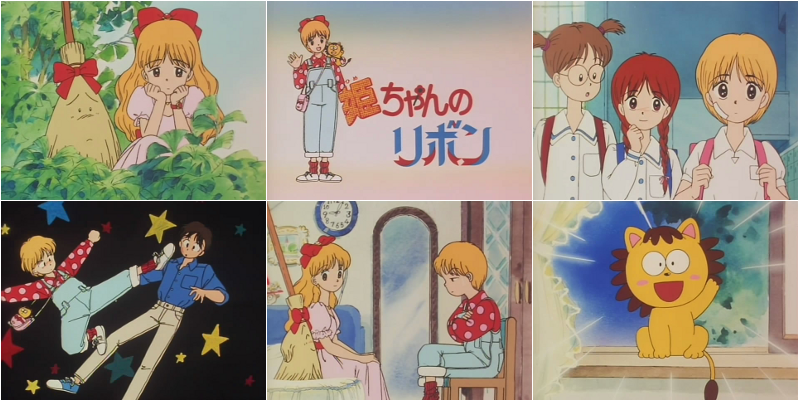
In writing my 1994 for the Golden Ani-versary blog, I noticed that Studio Gallop had a group of creative talent running through their shoujo anime similar to Sailor Moon‘s crew. This Akko-chan inspired series is the first in a run of shoujo manga adaptations.
Princess Erika from the Land of Magic arrives on Earth in search of her human lookalike to gift them a magic item. This item is a magic ribbon that allows the wearer to transform into someone else for an hour a day. If this proves useful over the course of a year, Erika will be able to become ruler of her land.
Her human twin is a 14 year old tomboy, Himeko Nonohara (both parts are non talking animal roles for Ikue Ohtani), who has a crush on an older boy at school and wishes she was more feminine like her big sister. While she sulks about kicking another boy in the head in front of her crush, Erika appears outside Himeko’s bedroom window.
She explains herself and the ribbon. As per usual there are a bunch of arbitary rules, you can’t tell anyone, and if you dont recite the reversal chant before the hour’s up you will be stuck in the form you turned into. Oh and Himeko’s plush toy lion, Pokota is brought to life by the ribbon too (voiced by Kazue Ikura, who would go on to cover for Ohtani as Tony Tony Chopper on One Piece when she was pregnant).
The first thing Himeko changes into is her big sister, and that’s where the episode ends.
This is a funny, charming show, with some great character designs from the debuting Hajime Watanabe. Watanabe provides a unifying look to these shojo adaptations, and then would go onto frequently collaborate with the director of two of them, Akitaro Daichi.
No Daichi yet though, he wouldn’t appear on the scene until 1994, the director on this series is Hatsuki Tsuji. Tsuji had been animating as far back as the second series of Lupin III, and was a mainstay at Gallop through the 80s. This was his first director credit though. More recently he’s been the man for bringing trading card games to life, directing Yu Gi Oh, Live On Cardliver Kakeru and Cardfight Vanguard.
The head writer was Takashi Yamada, who has been head writer on a list of shoujo shows as long as your arm.
- Crayon Kingdom of Dreams
- Heartcatch Precure
- Hime-chan’s Ribbon
- Little Red Riding Hood ChaCha
- Magical Doremi DOKKAN
- Mo~tto! Ojamajo Doremi
- Ojamajo Doremi
- Ojamajo Doremi #
- Onegai My Melody
- Onegai My Melody – Kuru Kuru Shuffle!
- Onegai My Melody Kirara
- Onegai My Melody Sukkiri
- Yumeiro Pâtissière
- Yumeiro Pâtissière SP Professional
I’m sure I’ve missed some, there’s plenty of others he’s written episodes for either under his real name or his pen names Midori Kuriyama and K.Y. Green. And even more that aren’t shoujo shows. Prolific is the word, currently he’s head writer on Danchi Tomoo.
Hiroaki Sakurai (Digi Charat, Cromartie High School) directed 10 episodes and would be a mainstay on these 90s Gallop shows. I think he’s the only episode director who’d be on the next Gallop show with Tsuji.
Animation directors Masayuki Onchi and Yoko Konishi would join Tsuji again on the next Gallop shoujo project, as would art director Shichiro Kobayashi.
Most of the script writers would return on future Gallop productions, including:
- Hiroshi Toda (scripts). Toda had been head writer on the first three seasons of Ranma 1/2.
- Shigeru Yanagawa (scripts). And Yanagawa had been head writer on the last three seasons of Ranma 1/2.
- Miharu Hirami (scripts). Hirami would be head writer on the 1996 Gallop show Kodocha.
- Ryousuke Takahashi (scripts, production co-operation). Takahashi’s work at Gallop tends to get overlooked in comparison to his famous mecha creations, but he worked on a lot of their output in the 90s.
- Tomoko Konparu (scripts). Already a veteran in 1992 having started on Ikkyu in the 70s, Konparu has been the head writer on lots of shows in recent years, including Tomorrow’s Nadja, Chi’s Sweet Home and Nodame Cantabile. However, her first head writer position had been the year before Hime-chan’s Ribbon when she was in charge of scripts on the Dear Brother… adaptation.
On a side note, this show appears to have been part of the early push for SMAP, featuring as it does two of their songs for the themes and one of the members in the cast.